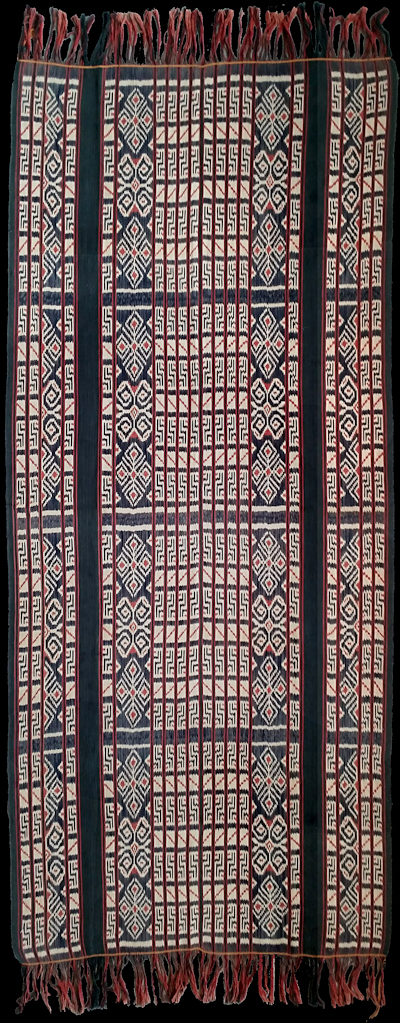| |
 
 | | | |
302 Roti Group, Roti
Lafa ina (horse blanket)
| | Locale: | Unidentified. | | Period: | 1940 | | Yarn: | Cotton, hand-spun, very fine, plus pinstripes in double-ply commercial cotton | | Technique: | Warp ikat | | Panels: | 2 | | Size: | 87 x 204 cm (2' 10" x 6' 8") LW: 2.34 | | Weight: | 460 g (16.2 oz), 259 g/m2 (0.85 oz/ft2) | | Design: | Four identical sections consisting of wider and narrower ikated bands. The chief motif, consisting of four lozenges arranged in diamond pattern around a smaller fifth diamond, probably represents a flower, and was mostly likely patola-inspired. Note in the bands to the sides only one half of the motif is used. This splitting of patola-derived motifs is typical for Roti and Ndao. | | Comment: | Lafa ina, horse blanket, which according to some sources is also used as a shroud or as bridewealth. Uncommonly generous proportions. The design of lafi ina calls for a strong red component. Another aspect to distinguish it from a men's shawl is the absence of fringes. All natural dyes. Clearly used fairly extensively. Somewhat faded (probably due to regular washing, which is hardly ever done to cloths meant for human use), but with a beautiful tonality and fine patina. All of the ikat was done on single-ply very fine hand-spun. The red pinstripes were done in what appears to be commercial cotton, used double ply. | | Background: | Chapters on Roti Group and Roti. | | Compare: | 107 | | Sources: | Similar to early 20th c. lafa ina in National Gallery of Australia, NGA 84.1103, but with richer ikat decoration. Same division of the field into four sections. Similar triple repeat per section of the motif in the main ikated bands. In this example the main ikated band is repeated twice per panel, in the NGA example the outermost ikated band carries a somewhat simpler star-like motif. In the NGA example the main ikated motif is a lozenge, here we see a more convoluted constellation of lozenges that in its contours itself is lozenge shaped. There is a similar example, without fringes, in the Georges Breguet collection. | | |

©Peter ten Hoopen, 2025
All rights reserved.
|
|


